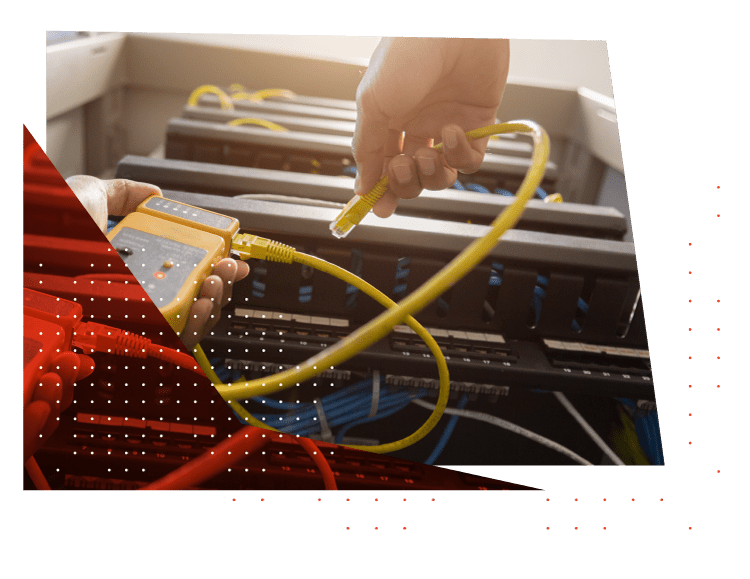05 May Optimizing Your Business with Network Audit Services
Are you tired of feeling like your business network is an unpredictable, tangled mess? If so, you may have heard about Network Audit Services and wondered how they could help you take control and optimize your infrastructure. Look no further! With a comprehensive network audit from a trusted service provider, you can identify potential vulnerabilities, ensure compliance with industry regulations, and improve your network’s security and performance. The benefits are endless, and peace of mind is priceless.
Network auditing can safeguard network architecture reliability, safety, and effectiveness. Network audits should be a regular part of your network management strategy. In this blog post, we will delve into the fundamentals of network audits to help you grasp their value and applicability to your business.

We will discuss key components of a network audit, differences between audits and assessments, when to conduct an audit, as well as preparing for one. Additionally, we’ll explore the significance of stakeholder buy-in during the process.
Finally, this post will guide you through collecting relevant information during the audit process while evaluating different network technologies that could potentially save costs.
What is Network Auditing – Understanding Network Audits
Network audits are comprehensive examinations of an organization’s IT infrastructure to identify potential areas for improvement or concern. It involves evaluating your network’s performance, security, and overall health to ensure it meets business requirements and industry standards. In this section, we will discuss the key components of a network audit and how they differ from assessments.
Key Components of a Comprehensive Network Audit
Network Performance Evaluation
This component focuses on analyzing the efficiency and effectiveness of your IT systems in meeting organizational goals. Evaluating network performance may include measuring response times, throughput rates, and other relevant metrics.
Network Availability
Network availability is another component of network auditing. It looks at the reliability and uptime of your systems, with the goal of ensuring that information and applications are always accessible to users. It also involves ensuring that relevant data is backed up regularly and stored at an offsite location for safekeeping in case of a disaster or data loss event. By doing so, organizations can maintain operational continuity even in the face of unforeseen circumstances.
Network Security Assessment
A critical aspect of any network audit is assessing its security posture by identifying vulnerabilities that could lead to data breaches or unauthorized access. Tools like Nessus, for example, can help network administrators scan your infrastructure for known vulnerabilities.
Policies and Procedures Review
Ensuring your organization has up-to-date policies governing various aspects, such as password management or incident response, is essential during an audit process. These policies should align with best practices recommended by organizations like the National Institute of Standards and Technology (NIST).
Benchmarking Against Industry Standards
Effective network auditing also includes comparing your current setup against established industry benchmarks, such as those provided by the Center for Internet Security (CIS Controls), to identify gaps in compliance.

Differences Between Audits and Assessments
Audit and assessment are terms often used interchangeably but have distinct differences. An audit of a network is a thorough examination to evaluate its performance, security, and adherence to industry standards. A comprehensive analysis is performed utilizing specialized approaches and instruments to detect potential issues or areas for improvement.
On the other hand, an assessment is a more focused examination of specific aspects of your IT environment. For example, a vulnerability assessment would concentrate on identifying weaknesses within your systems that attackers could exploit while ignoring other factors, such as policy adherence or benchmarking against industry standards.
In summary, while both audits and assessments aim to improve the overall health of your IT infrastructure, their scope differs significantly – with audits being broader in nature compared to assessments that target specific concerns within the organization.
Understanding network auditing is essential for any business, as it provides an in-depth look into the health and performance of its IT infrastructure. A comprehensive audit can aid in detecting possible issues before they become serious. It’s important to know when to conduct a network audit to ensure your system remains secure and compliant with industry regulations.
Network Security Audit
Ensuring your network’s security is crucial, so conducting network security audits separately from other network auditing is recommended. Network security audits should mainly focus on the following:
- Network data security: Verify that data in motion and at rest on network endpoints are secure. Are appropriate encryption methods followed, and are access controls in place to restrict unauthorized data access? Is any identifiable personal information anonymized?
- Network access control: What authentication protocols and procedures are in place to protect network access? Does a new device gain instant access to the network, or does an authorized user need to enter credentials first? Are the same access controls enforced for both wired and wireless connections? Look for and identify unauthorized access points. Are up-to-date authentication protocols used while avoiding protocols with known flaws, such as WEP? Are there any unnecessary open ports on the network? Are users required to change their passwords occasionally?
- Physical security: Verify how physical access to the network is secured. Is any networking equipment accessible from areas that do not require keys or other access controls to enter?
- BYOD policy: If employees are allowed to use their devices at work, what are the specifics of the BYOD policy, and are they duly enforced?
Performing a thorough network security audit can identify potential vulnerabilities, providing the opportunity to address them proactively to avoid the risk of data breaches.
When to Conduct a Network Audit
A network audit should be timed around important technology decisions or business requirements. An audit conducted at an opportune moment can guarantee that your IT framework is coordinated with the objectives and aspirations of your organization. In this section, we will discuss some common triggers for network audits.
Mergers and Acquisitions
During mergers and acquisitions (M&A), it is crucial to assess the combined IT infrastructure of both organizations. A network audit conducted by ACIS IT Solutions can help identify any potential compatibility issues, redundancies, or security risks that may arise from integrating two separate networks.
Regulatory Compliance
Specific industries are subject to strict regulatory standards regarding data protection and privacy. For instance, HIPAA sets the data protection and privacy standards that healthcare providers must abide by. Regular network audits are necessary to ensure compliance with these regulations to identify vulnerabilities in your system that could lead to breaches or unauthorized access.
System Upgrades
- New hardware: When introducing new hardware devices into your existing infrastructure, conducting a network audit beforehand is essential. In addition to ensuring compatibility, this provides that outdated equipment is not causing performance bottlenecks.
- New software: Implementing new software applications also requires careful consideration of their impact on overall system performance. An audit helps determine if sufficient resources are available for smooth operation without causing disruptions elsewhere within the organization.
Recurring Issues
If you’re experiencing recurring problems such as frequent downtime or slow application response times, a network audit can help pinpoint the root cause of these issues. By identifying and addressing underlying problems within your IT infrastructure, you can improve overall performance and prevent future disruptions to business operations.
Performing a network audit is essential to maintain your business’s compliance with the newest technologies and regulations. It also helps identify recurring issues or system upgrades needed for optimal performance. Preparing for a network audit requires building a network device inventory list, identifying obsolete devices, and evaluating software applications and the operating systems that host them), all of which can be done by enlisting the help of ACIS Low Volt.
Preparing for Your Network Audit
To start your network audit effectively, you must gather all relevant information about your existing infrastructure. Building an inventory of hardware devices and software applications within the organization is part of this process. It also determines if any are obsolete or pose security risks. The following outlines the most critical parameters to consider when conducting a network audit. When creating your network audit template, including the following processes to ensure a comprehensive evaluation is essential.
Building an Inventory List
An accurate inventory list is essential for a successful network audit. Start by noting all physical equipment, including network devices, servers, switches, routers, firewalls, and desktops. Additionally, make a record of virtual machines and cloud-based solutions that are part of your IT environment. A network discovery tool like Spiceworks Network Inventory can help automate this process.
Identifying Obsolete Devices
Aging hardware can lead to performance issues and increased security vulnerabilities. During the audit preparation phase, identify outdated equipment manufacturers may no longer support or fail to meet industry standards. Replacing these devices with newer models will improve efficiency and reduce potential risks.
Evaluating Software Applications
In addition to hardware components, assessing the software applications used throughout your organization is crucial. Compile a list of installed programs on each device, their respective versions, and licensing details. Check for updates or patches available from vendors that address known security flaws or compatibility issues with other systems.
It would be best to consider whether particular applications are still necessary for daily operations – eliminating unused software can free up valuable resources while reducing potential attack vectors for cybercriminals.
Proper preparation is essential for a successful network audit. By ensuring that key stakeholders are informed and on board, the process of completing an effective audit will be significantly simplified.
The Importance of Stakeholder Buy-In
Obtaining stakeholders’ buy-in is crucial when conducting a successful network audit. In addition to ensuring everyone understands its purpose, auditors can access the credentials they need during the assessment. Communication with key decision-makers and documenting necessary credentials are discussed in this section.

Communicating with Key Decision-Makers
Effective communication is vital in ensuring stakeholder buy-in for your network audit. By clearly explaining the objectives and benefits of an audit, you can gain support from management, IT staff, and other relevant personnel within your organization. Some strategies to achieve effective communication include:
- Holding informational meetings or presentations about the audit process
- Distributing written materials outlining the goals and expected outcomes of an audit.
- Addressing any concerns or questions raised by stakeholders promptly and thoroughly.
- Demonstrating how a network audit aligns with overall business objectives such as cost savings or improved efficiency.
Keeping communication channels open and active throughout the auditing process is critical for ensuring stakeholders stay abreast of progress updates while building trust between all participants. Keeping stakeholders informed on progress updates fosters trust between all parties.
Documenting Necessary Credentials
A critical aspect of preparing for a network audit involves gathering all the required credentials auditors need during their assessment process. These may include login information for servers, routers, switches, firewalls – essentially any device connected within your IT infrastructure.
To ensure smooth execution without delays due to missing credentials, consider taking the following steps:
- Create a centralized repository where all necessary login details are securely stored. Use password management tools like LastPass or 1Password.
- Establish clear protocols for granting auditors access to these credentials, including any necessary approvals from management or IT staff.
- Regularly update and maintain this repository as devices are added, removed, or modified within your network infrastructure.
By ensuring stakeholder buy-in and properly documenting the required credentials, you can set the stage for an efficient and effective network audit that yields valuable insights into your organization’s IT infrastructure. In the long run, this will improve the company’s security, performance, and overall operations.
It is essential to secure the support of stakeholders when conducting a network audit, as their buy-in can be invaluable for ensuring successful implementation. During an audit, gathering the necessary data to assess and evaluate a company’s IT setup is essential. A formal audit report is made following the identification of threats, which management and other stakeholders review.
Collecting Relevant Information During the Audit Process
To make informed recommendations based on your specific needs, it’s essential that auditors collect accurate data during their evaluation. Gathering pertinent details related directly to those goals set forth by management can provide actionable insights tailored specifically toward improving overall operations.
Reviewing System Logs
An essential aspect of collecting relevant information is reviewing system logs. These logs contain valuable data about network activity and performance, including any errors or security incidents that may have occurred. Analyzing these records allows auditors to identify patterns and trends that could indicate potential issues within your IT infrastructure. For example, a high number of failed login attempts might suggest unauthorized access attempts or weak password policies in place. Check out this SANS whitepaper to learn more about how system logs can help improve network security.

Analyzing Traffic Patterns
A thorough analysis of traffic patterns is another crucial component when collecting relevant information during a network audit process. Examining bandwidth usage across different devices and applications is one way to identify bottlenecks and areas with excessive congestion that affect overall performance. A network audit tool can help administrators visualize traffic flow and pinpoint problem areas within your organization’s network.
- Identify peak times: Understanding when the highest traffic volume occurs helps determine if additional resources are needed during these periods.
- Detect anomalies: Unusual spikes in traffic may indicate potential security threats or network misconfigurations that need to be addressed.
- Optimize resource allocation: Analyzing traffic patterns can help identify areas where resources could be better utilized, leading to cost savings and improved performance.
Assessing Security Measures
The final step in collecting relevant information during a network audit is assessing the current security measures in place. Evaluating the efficacy of protective measures such as firewalls, antivirus software, and IDS is essential to determine the security of an organization’s data. Some crucial aspects of this assessment include:
- Patch management: Ensuring all devices are updated with the latest security patches helps minimize vulnerabilities that cybercriminals could exploit. Ensure the security patches for network software are current.
- Password policies: Implementing strong password requirements and regular password changes can significantly reduce the risk of unauthorized access.
- Data encryption: Encrypting sensitive data both at rest and in transit provides an additional layer of protection against potential breaches. Some tools offer user-friendly solutions for implementing robust encryption practices within your organization.
Gathering accurate and relevant information throughout the network audit process allows IT consultants to provide tailored recommendations based on your unique business needs while ensuring optimal performance levels are maintained across all aspects of your infrastructure. By proactively addressing any identified issues, organizations can avoid costly downtime events while enhancing overall cybersecurity posture.
Gathering pertinent data during the audit is critical to uncovering any security issues and weaknesses. Now, let us move on to evaluating network technologies that can provide cost-saving opportunities while ensuring optimal performance.
Evaluating Network Technologies
Part of a network audit involves evaluating the various technologies in use, such as SD-WAN or MPLS. As a result, organizations can make informed decisions about what technology best suits their needs, improving overall performance and reducing costs simultaneously. We will compare SD-WAN and MPLS in this section and identify cost-saving opportunities.
Comparing SD-WAN vs. MPLS
SD-WAN (Software-Defined Wide Area Network) is a modern approach to managing wide area networks that provide centralized control over network traffic through software-defined policies. It offers several benefits, such as:
- Better application performance due to intelligent routing and prioritization of traffic
- Easier deployment and management compared to traditional WAN solutions.
- Cost savings by leveraging lower-cost broadband connections instead of expensive leased lines like MPLS circuits.
- Built-in security features, including encryption and firewall capabilities.
MPLS (Multiprotocol Label Switching), on the other hand, is an older networking technology that uses labels attached to packets for efficient data forwarding across long distances. While it has been widely used for years due to its reliability and low latency, there are some downsides:
- Limited flexibility when it comes to adding new sites or changing configurations quickly
- Higher costs associated with dedicated leased lines required for connectivity
- Lack of built-in security features, often requiring additional hardware investments.
When evaluating SD-WAN vs. MPLS for your organization, it’s essential to consider cost, flexibility, security requirements, and application performance factors. For many businesses today, the benefits of SD-WAN outweigh those offered by traditional MPLS networks. p >
Identifying Cost-Saving Opportunities
As part of a network audit, identifying opportunities for cost savings is crucial in ensuring that your IT infrastructure remains efficient and budget-friendly. Some potential areas where you can save money include:
- Migrating from expensive leased lines (MPLS) to more affordable broadband connections with SD-WAN technology
- Optimizing traffic routing and prioritization to reduce bandwidth consumption
- Consolidating hardware devices or eliminating unnecessary equipment through virtualization technologies
- Outsourcing certain IT functions to managed service providers like ACIS IT Solutions, who can provide expertise at a lower overall cost than maintaining an in-house team.
In conclusion, conducting a thorough network audit will help you decide which networking technologies best suit your business needs while uncovering potential cost-saving opportunities. By partnering with experienced structured data cabling experts like ACIS Low Volt, you can ensure that your organization’s infrastructure remains secure and efficient well into the future.
Assessing network systems is fundamental to guarantee that your enterprise has the most economical and dependable IT framework. By finding an experienced IT consultant to help you with this process, you can rest assured knowing that all aspects of your network are being thoroughly evaluated.
Contact ACIS Low Volt for Network Auditing
Network audits are vital to ensuring your business is running as efficiently and securely as possible. Gaining insight into a network audit, preparing for it, gathering the necessary data during it, and examining technologies are all critical to guaranteeing your business’s IT infrastructure is compliant with safety and performance standards.
Let ACIS IT Solutions help you streamline your network operations and maximize efficiency with our comprehensive audit services. Get in touch today to learn more about how we can make sure your systems are running at peak performance!


